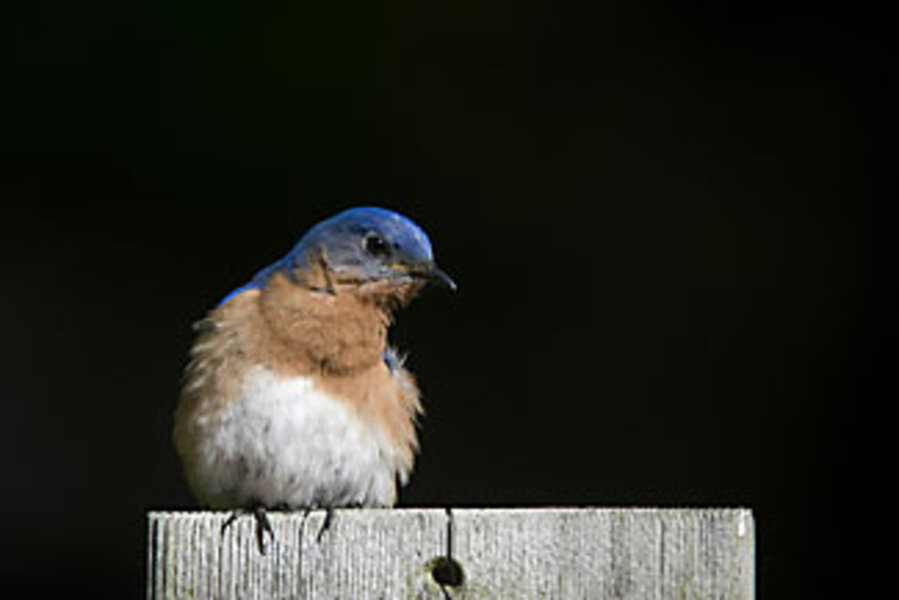A bluebird summer
Loading...
This summer finds me a self-designated godmother to a slowly increasing number of fledgling eastern bluebirds – 10 and counting. Witnessing the mysterious progression of birth and growth is inspiring – starting from the first glimpse of pale blue eggs in a perfect pine needle nest to newly hatched bundles of pink-gray skin to young birds sporting pin feathers and comically contrasting yellow, liplike bills. These little creatures will become those special birds splashed in lapis lazuli blue – a species loved by almost everyone.
During spring, I worried about cold weather and rain, and now that it's summer, I get concerned about heat and snakes. I question the motives of blue jays flying overhead (they're known to snack on young bluebirds). House wrens set me on edge (they destroy bluebird eggs and take over their nest sites).
In fact, since I've jumped into a bluebird monitoring project with Ken Leister, the Chester County coordinator for the Bluebird Society of Pennsylvania, I'm more attuned to the threats these babies face. Ken, a semiretired supervisor of specialty construction projects, builds bluebird boxes from scrap cedar planks the way some people whip up batches of chocolate-chip cookies.
After reading about Ken's bluebird project in a township newsletter last spring, I decided to help him put up 14 bluebird boxes in a park near my house and monitor bluebird nesting through three spring/summer nesting cycles. I'd been looking for just this sort of volunteer assignment, something positive I could do in southeastern Pennsylvania where suburban sprawl has eliminated many suitable bluebird nesting sites.
The insect-eating eastern bluebird suffered a severe population decline between the 1940s and 1970s from habitat destruction and DDT use. They are coming back, but they still need human assistance to recover to the population levels existing before housing developments proliferated and competition increased from the nonnative species such as the English (house) sparrow.
The project involves erecting nest boxes in appropriate habitat – a grassy field with a healthy insect population away from water (liked by raccoons, another predator of baby bluebirds) and underbrush (liked by house wrens). I check the boxes weekly throughout the summer to determine what species are using the boxes, record the numbers of eggs and hatchlings, and note whether there are any signs of predators. At summer's end, we'll report fledgling information to the Bluebird Society to help track population recovery.
During Week 1, Ken handed me an information sheet explaining the differences in the nests I would see being built. According to the sheet, bluebird nests are fashioned mostly of grass. Obviously, the bluebirds in this park didn't study Ken's sheet and use almost exclusively pine needles that drop from the many white pines surrounding the field. I'm pleased when the circles of pine needles quickly became shallow cups and then handsome deep cups within a couple of weeks.
Soon the situation resembles a neighborhood housing-rights drama. Several species of cavity nesters are thrilled to begin housekeeping in "bluebird" boxes: chickadees, tree swallows, house wrens, and English sparrows. The two former will move into the boxes, but the two latter are more aggressive. The house wrens build the equivalent of a twig McMansion on top of a bluebird nest. The English sparrows will destroy the eggs, the hatchlings, and sometimes the bluebird parents.
The first bluebird eggs – pale blue and the size of miniature chocolate Easter eggs – appeared in a clutch of three during Week 2, one of four active bluebird nests. During the fifth week, I gasped when I opened the box to my first hatchlings – three of them, lying in a row, heads tucked out of sight like little loaves. I shut the door quickly and moved on to encourage the mother to come back.
Bluebirds are tolerant of people looking in their nests, but I don't want to disturb them unduly. The female bluebird in Box 4 often simply refuses to move when I knock. She glares at me through the front hole then settles back on her brood. It's as if she thinks I'm soliciting door-to-door, and she won't have any of what I'm selling. I leave her in peace.
After each monitoring trip, I walk home with my clipboard showing another week's progress of busy avian lives and interspecies competitions. I notice I often hold my breath, hoping conditions will be right – weather, food, parenting – to fledge most of the bluebird hatchlings this summer. I consider myself, my family, and people down the street and across the globe – how we all wish that conditions will be right for us to live abundantly. Yet at the same time, we realize how fragile and impermanent our situations can be. Against the threat of heat, cold, hunger, and competition, we seek the same grace in our lives that allows the bluebird egg to hatch and the hatchling to fly.





